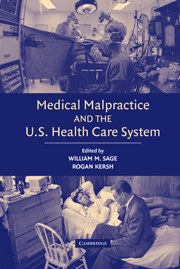Book contents
- Frontmatter
- Contents
- List of Contributors
- Introduction
- PART ONE FRAMING MEDICAL MALPRACTICE AS A HEALTH POLICY ISSUE
- PART TWO THE HEALTH POLICY IMPACT OF MEDICAL MALPRACTICE
- 4 Who Pays When Malpractice Premiums Rise?
- 5 The Effects of the U.S. Malpractice System on the Cost and Quality of Care
- 6 Liability, Patient Safety, and Defensive Medicine: What Does the Future Hold?
- 7 Medical Liability and the Culture of Technology
- PART THREE MALPRACTICE REFORMS THAT SOLVE THE RIGHT PROBLEMS
- PART FOUR IN SEARCH OF A “NEW PARADIGM”
- Bibliography
- Index
7 - Medical Liability and the Culture of Technology
Published online by Cambridge University Press: 10 December 2009
- Frontmatter
- Contents
- List of Contributors
- Introduction
- PART ONE FRAMING MEDICAL MALPRACTICE AS A HEALTH POLICY ISSUE
- PART TWO THE HEALTH POLICY IMPACT OF MEDICAL MALPRACTICE
- 4 Who Pays When Malpractice Premiums Rise?
- 5 The Effects of the U.S. Malpractice System on the Cost and Quality of Care
- 6 Liability, Patient Safety, and Defensive Medicine: What Does the Future Hold?
- 7 Medical Liability and the Culture of Technology
- PART THREE MALPRACTICE REFORMS THAT SOLVE THE RIGHT PROBLEMS
- PART FOUR IN SEARCH OF A “NEW PARADIGM”
- Bibliography
- Index
Summary
During the past thirty years, the United States has witnessed three separate medical liability crises. One common theme has been the outcry for reform and the concomitant failure to effectuate meaningful change. Each crisis has led to incremental reforms, but fundamental changes in how medical professional liability is determined have remained elusive.
Despite all the attention accompanying these crises, one aspect, medical technology, has not featured prominently in the liability debate. This chapter explores the central but often unappreciated role medical technology plays in the recurring malpractice crises. The analysis will attempt to demonstrate several premises. First, culture is the most important factor driving technology development and use. Second, technology is the principal driver of health policy through its impact on cost, access, and quality. Third, technology is the primary driver of negligence law. Fourth, the history of medical malpractice liability is synonymous with the development of medical technology.
In short, the culture of technology drives medical liability. For any malpractice reform effort to be effective, it must take account of how technology influences malpractice liability. Tort reform that fails to deal with the historical and cultural determinants of technology use is unlikely to alter the basic dynamic of the recent malpractice crises.
The chapter adopts the Institute of Medicine's (IOM's) broad definition of technology as “techniques, drugs, equipment and procedures used by health care professionals in delivering medical care to individuals and the systems within which such care is delivered.
- Type
- Chapter
- Information
- Medical Malpractice and the U.S. Health Care System , pp. 115 - 134Publisher: Cambridge University PressPrint publication year: 2006
- 1
- Cited by

